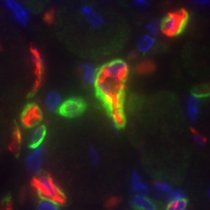
Organoid News
@organoidscience
Followers
14K
Following
7K
Media
3K
Statuses
8K
An online resource for researchers studying and using organoids. Part of the @STEMCELLTech Science News service.
Vancouver, British Columbia
Joined September 2017
We know scientists have busy schedules. 🤷 That's why we put together #Organoid News, an online publication and bi-weekly email newsletter covering the latest research into organoid technology. 📰 Subscribe here: https://t.co/Np2i1Zz3tr
0
0
9
Want to know how electrical activity emerges in human brain #organoids? ⚡🧠 Scientists review current knowledge on the molecular and electrophysiological determinants of neuronal maturation and network computations. https://t.co/x2WnUAyvFF
1
5
19
🧠 An encapsulation approach was devised in which human brain microvascular endothelial cells are delivered to developing cerebral #organoids from progressively degrading extracellular matrix-based hydrogel droplets. 👉 https://t.co/7yEe54KpAA
0
4
13
🧫 Researchers at @unibirmingham present a multiorganoid platform that combines cardiac and bone marrow organoids in a 3D-printed, fluidically connected device housed within a 6-well tissue-culture plate @CircRes | https://t.co/1oW7dSxtpz
0
0
15
⚡ Check out this novel differentiation protocol that enables short-term activation of retinoic acid signaling during the early intermediate mesoderm (IM) stage, enabling co-induction of anterior and posterior IM lineages. 👉 https://t.co/qXITHvInOZ
0
0
5
🧫 Researchers with Laura Rijns demonstrate the essential role of the IKVAV motif in guiding intestinal organoid polarity in synthetic dynamic hydrogels – paving the way for the future design of synthetic systems to culture complex living tissue. 🔗 https://t.co/jnz1xAHuDG
0
1
3
Human brain #Organoid scRNAseq + scATACseq + single-cell transcription factor perturbation (CROP-seq, lentiviral gRNA library for 20 TFs, 3 gRNAs/TF, 1 gRNA detected/cell in >22k cells) in GLI3-HES1 antagonism for dorsoventral patterning in human telencephalon Pando:
0
33
212
Save this review for your weekend. 🔖 The article details how immune-organoid co-cultures can model mucosal immunity at each stage of a functional inflammatory response. 🔓 More in @CellReports: https://t.co/y7my72eG7A
0
10
18
Collaborators from @hkusbms shared #organoid-based CRISPR screening findings that showed that gastric cancer depends on fatty acid and cholesterol synthesis and responds well to the ACC inhibitor ND646 and the lanosterol synthase inhibitor RO 48-8071. https://t.co/IIDx141kdM
0
0
1
Most kidney organoids may present non-renal cell populations such as cartilage. Dr. Vanessa LaPointe's team (@LaPointeLab) found that FGF9-treated kidney #organoids have reduced cartilage and diminished #chondrocyte marker expression. https://t.co/5Rm53WgtAn
0
3
9
Get to know a 3D cultured apical-out porcine intestinal #organoid model, comprising a variety of cell types, including intestinal stem cells, enterocytes, goblet cells, proliferative cells, Paneth cells, and enteroendocrine cells. 🔗 https://t.co/xFBFn9O2BI
1
1
10
🧠 Scientists at @UofT utilize iPSC-derived cerebral organoids from bipolar disorder patients and healthy controls to model disease-specific metabolic and inflammatory dysfunction in a more physiologically relevant system. 👉 https://t.co/XlfSYWJMmu
0
2
15
📊 Dr. Zhijun Yu and team at @prinsesmaximac employed single-nucleus multi-omics analysis on over 100,000 high-quality nuclei to investigate the molecular landscape of both primary tissue and patient-derived organoids. @IntJCanc | https://t.co/2zLNNRQfqo
0
1
4
⚡ Scientists at @TU_Muenchen demonstrated the effectiveness of 3D microelectrode arrays by recording electrophysiological activity from hiPSC-derived cortical organoids both in situ and after 10 days of cultivation. 🔗 https://t.co/Za8GysDdky
0
0
8
🧫 Scientists employed iPSCs to generate pituitary #organoids harboring the patients’ human leukocyte antigen haplotype and cocultured the organoids with PIT-1-reactive cytotoxic T cells isolated from the patients’ PMBCs. @NatureComms | https://t.co/Ow8L5iEorX
0
1
8
🧠 Researchers at @IUBloomington introduce human cortical organoid microphysiological systems to study Alzheimer’s disease monocyte-mediated neuroinflammation. @ScienceAdvances | https://t.co/v0YQNbjOtu
0
1
10
🧫 Scientists developed a co-culture system using a combination of human embryonic stem cell-derived blood vessel organoids and mesenchymal stem cells. 🔗 https://t.co/CkzcZa7bg7
0
5
18
Scientists used a lipopolysaccharide (LPS)-induced human kidney #organoid (HKO) model to investigate ferroptosis in sepsis-induced acute kidney injury. They established that USP18-STING1 axis plays role in LPS-induced ferroptosis in HKOs. https://t.co/1U2aPolagT
0
0
9
Dr. Lena Smirnova and colleagues validate neural #organoids as an in vitro model of learning and memory, providing a human-relevant platform for translating basic science to human applications. 🧫 @CommsBio | https://t.co/jLr0nNdgr7
0
4
17
Current testicular organoids (TOs) mostly fail to recapitulate the native testicular architecture and function. 👎 Scientists developed a novel approach to improve TO development from dissociated testicular cells. 🧫 More here: https://t.co/xteUaCJuJQ
0
3
15























